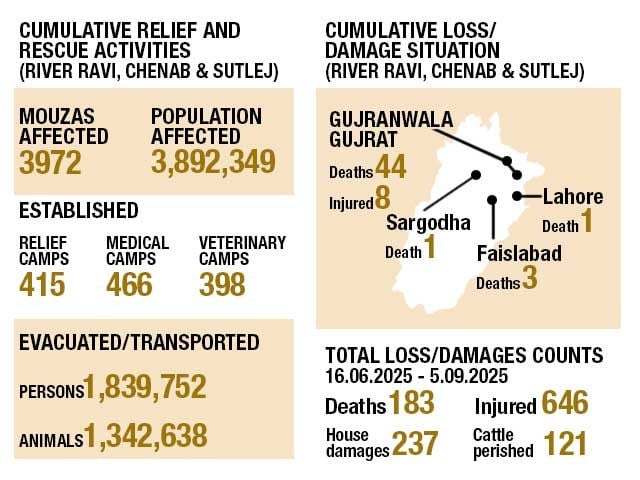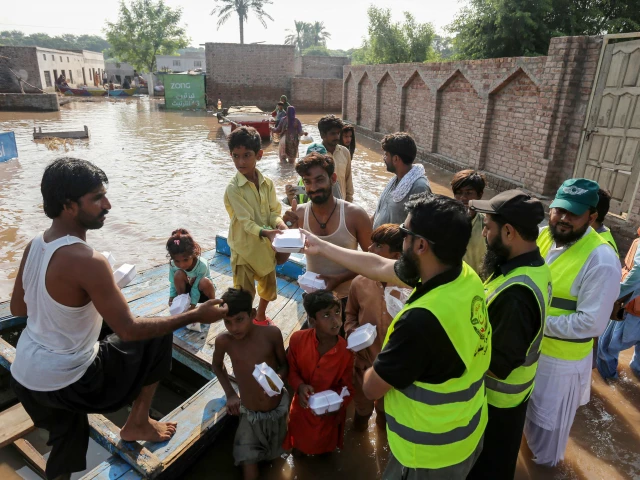LAHORE:
The NDMA on Friday warned of worsening floods in Punjab with heavy rains forecast from Sept 7–9, raising the risk of urban flash flooding as high floods in rivers Chenab and Sutlej submerged villages near the bank of rivers.
According to the National Emergencies Operation Centre (NEOC), intense monsoon activity is expected to hit Islamabad and several districts in Punjab, raising alarms over potential flash floods and hill torrents.
The advisory has flagged cities including Rawalpindi, Murree, Lahore, Faisalabad, Gujranwala, and Sialkot, among others, where poor drainage systems could fail under the pressure of continued downpours.
اسلام آباد اور پنجاب کے بیشتر اضلاع میں 7 تا 9 ستمبر بارشوں کا امکان۔مری، اسلام آباد راولپنڈی جہلم، چکوال، اٹک، منڈی بہاؤالدین، گجرات، گوجرانوالہ، حافظ آباد، چنیوٹ، لاہور، سیالکوٹ نارووال شیخوپوره، فیصل آباد، سرگودھا میں شہری سیلاب اور ندی نالوں میں طغیانی کا خدشہ ہے۔ pic.twitter.com/W6XbbYknZU
— NDMA PAKISTAN (@ndmapk) September 5, 2025
In South Punjab, vulnerable low-lying areas in Bhakkar, Layyah, Mianwali, Bahawalpur, and Rahim Yar Khan are also at risk. Many of these regions are already reeling from recent floods and face renewed threats due to saturated ground and damaged infrastructure.
The NDMA has called on residents in high-risk areas to remain vigilant, avoid travel on flooded roads, and prepare for possible evacuation. Citizens have been urged to move livestock and essential belongings to higher ground and stock up on emergency supplies including dry food, drinking water, and medicines.
The authority has also warned of potential outbreaks of waterborne diseases following stagnant water accumulation, urging communities to take preventive health measures.
Punjab reports 68 deaths as flood crisis worsens
Meanwhile, the flood crisis in south Punjab intensified on Friday as with rivers Chenab and Sutlej breaching embankments and submerging dozens of villages. This flood spell has claimed at least 68 lives across the province as per the Provincial Disaster Management Authority (PDMA) and left scores injured.
River water from the Chenab engulfed large parts of Sher Shah in Multan. Flood waves as high as 12 to 14 feet washed away dozens of settlements. Boats were summoned to evacuate stranded families, who had rushed to their rooftops to escape the flood.
Displaced residents from inundated Basti Khoor have set up camp along the Sikandari canal embankment, where many families are living in the open. Tents are limited, and livestock and household goods are scattered along a one-kilometre stretch near the canal. Rescue and relief teams were yet to reach the site by the time this report was filed.
Read: ECP postpones Punjab by-elections due to devastating floods
Meanwhile, Sutlej River swept through dozens of villages in Vehari and Bahawalpur districts. Hundreds of homes, schools and dispensaries were destroyed.
In Vehari, water levels at Head Islam were reported to be 102,000 cusecs, and over 335,000 cusecs at Head Ganda Singh. Discharge at Head Siphon stood at 93,000 cusecs and at Head Mian Haakim outfall touched nearly 200,000 cusecs. Several protective embankments gave away and Kuttabpur Wagi, Jhoke Fazil, Jhoke Jando, Jhoke Sathu, Kaliya Shah and Hasan Shah villages, among others, were completely submerged.


Design by Ibrahim Yahya
Similarly in Bahawalpur, the Sutlej caused widespread destruction with over 90% of protective embankments collapsing. The flood water surged into over a 100 villages, as high as 100,000 cusecs at Empress Bridge for instance.
Emergency medical support was rolled out through 26 “clinic-on-wheels” units and a field hospital at Jhangra Sharqi. Livestock vaccination campaigns were launched as well. Some 82 schools were converted into temporary relief camps.
Read more: Punjab devastation raises red flag for Sindh’s crops
The district administration said around 42,000 people and nearly 25,000 livestock have been relocated. The floods devastated residential settlements besides thousands of acres of sugarcane, maize, sesame crops and fodder.
According to the PDMA, nearly 4,000 mouzas (pieces of land) have been affected across Punjab, leaving near 3.9 million people impacted. Of these, 1.8 million people are evacuaees. Relief agencies have established as many as 416 relief camps, 356 medical camps and 318 veterinary camps. Over 1.3 million livestock has also been moved to safer ground.
Water levels also remained high at Kot Mithan and Rojhan in Rajanpur district. At the former, water level was recorded at 490,000 cusecs. As per PDMA data, since mid-June at least 183 people have died, 646 injured and 237 houses have been destroyed in monsoon rains and flooding across Punjab. As many as 121 cattle have perished. District data shows heavy losses in Bahawalpur, Muzaffargarh and Vehari.

